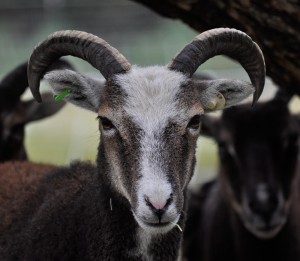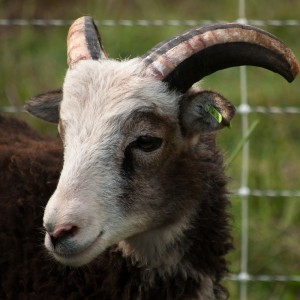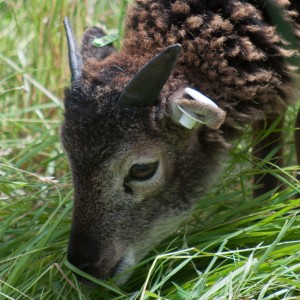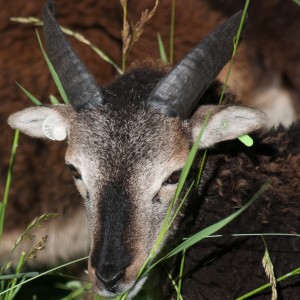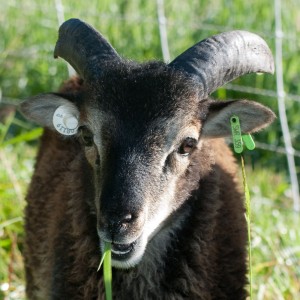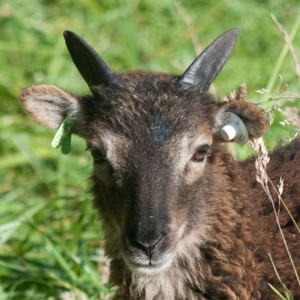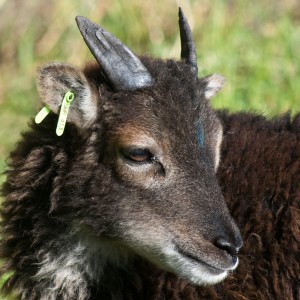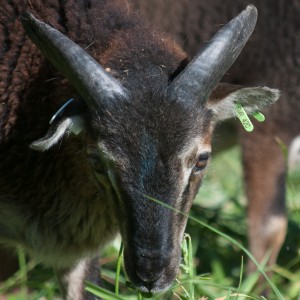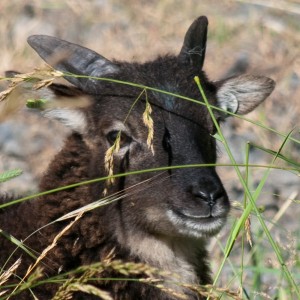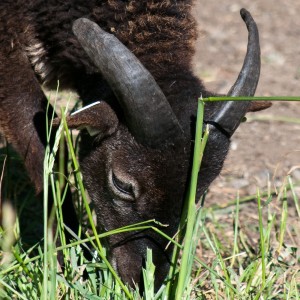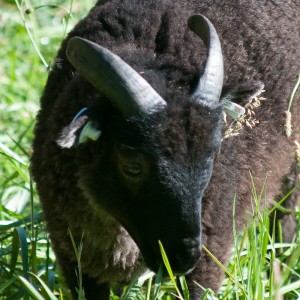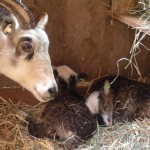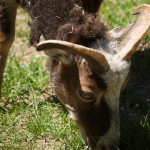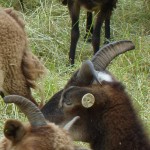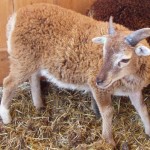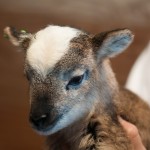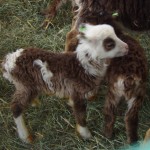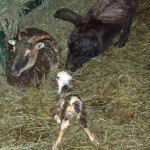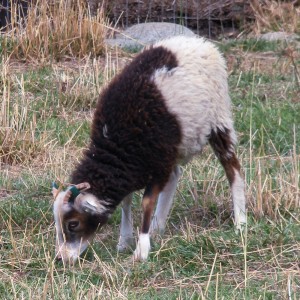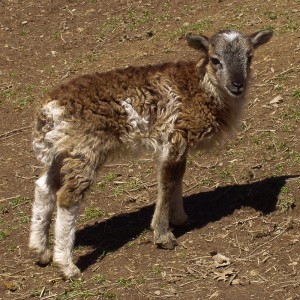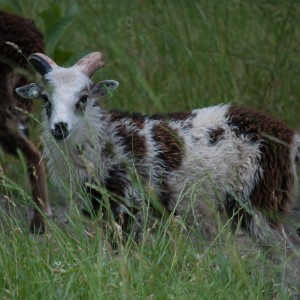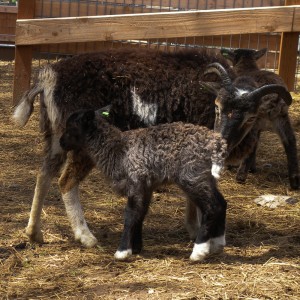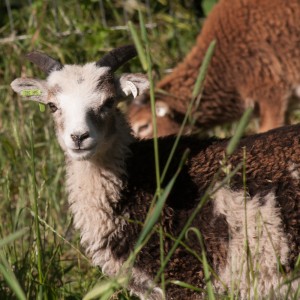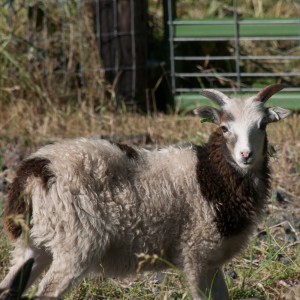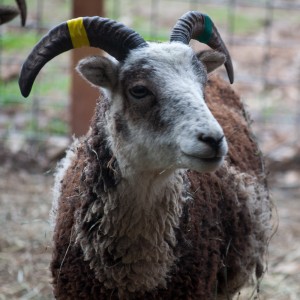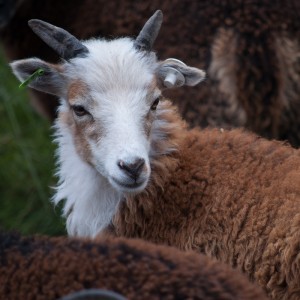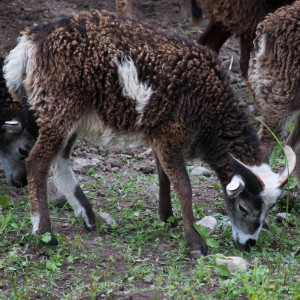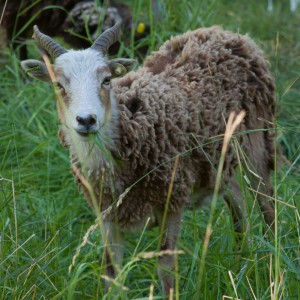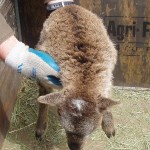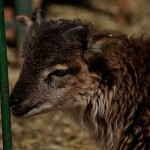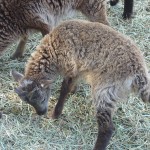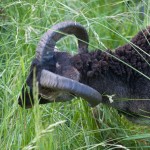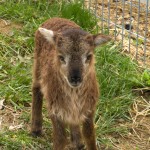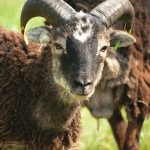White spotting in Soay sheep
Over the last few months, we have received a number of questions about white spotting, one of the most visible traits in British Soay sheep. I have to admit I never gave much thought to spotting until now; it was just there in our flock. But worried Soay sheep colleagues sooner or later worry me, so I thought it might be helpful to address their questions in a couple of blog posts. Here are the types of questions we’ve gotten:
- Is white spotting rare or common?
- How unusual is it to have a lamb with a whole lot of white on many different parts of its body?
- In terms of genetics, if the only white is a “wisp” or “twink” between the ears or on the forehead, is the animal “white spotted” or just a “carrier”?
- Should I worry about breeding “too much” white into my flock?
How common are white-marked Soay sheep? In other words, what is the frequency of the white spotting (“ss”) phenotype?
The foundation flock in Athelstan, Canada. None of the six Soay sheep brought to Canada by John Hooper and his company, Phoenix Life Sciences, in 1990 exhibited white patches, but several of them had to have been carriers. We know this from the very first Soay lamb born in the Phoenix flock, a blotchy ram lamb named Nougat (Phoenix #01). The next spring, three of the 1991 lambs also showed white: Rue (Phoenix 08), her twin Rosemary (Phoenix 06), and Comfrey (Phoenix 03). And so it went down through the years.
Two decades of spotted Soay sheep in North America. We have pretty good data on the Soay sheep born in North America for the first twenty years after the importation to Athelstan in 1990. During that time (1990-2009), about 685 lambs arrived on 23 different farms (4 in Canada, 19 in the U.S.). Of this number about 66, or 9.6 % — about one in ten — were reported as white spotted.
Although the core data for these 600 + lambs — date of birth, parents, name — seems solid, we have less confidence about the consistency of reporting on white markings, especially where the extent of spotting was minor or inconspicuous (did you notice how many times I said “about” in reporting the spotting rate?). Accordingly, the true rate almost certainly was somewhat higher during those twenty years, but we have no way to know how much higher.
Fortunately, we can look to another data set, and one which we don’t mind saying is pretty reliable – the British Soay sheep born on our own farm.
Our foundation flock.In 2005 and 2006, we acquired 39 RBST Soay sheep from five other farms (Blue Mountain, Greener Pastures, USA0001, USA0002, and USA0003). These were our “foundation” animals.
[math]! \frac {( 1 / 10 + 3 / 29 )} { 2 } \approx 0.10 [/math]
Four of the 39 (about 10 %) — three ewes and one ram — showed white markings (“ss”). A very rough approximation of the expected proportion of “ss” descendants from these four animals is 10 %, more or less.
Eight years of lamb data on our farm. Beginning in 2006 and through our 2013 lambing, 404 British Soay sheep were born on our farm. Of these, 40 (10.1 %) show white patches. The circumstance that our percentage of “ss” lambs is in the same statistical ballpark as the expected proportion given our foundation animals comes as no surprise: we breed neither “for” nor “against” white spotting. If an “ss” ram lamb comes up in the formal rotation, he breeds. If he does not, he goes to a new home, just like the rest of the outcross rams.
There is an additional reason why our percentage of lambs with white patches continues at about 10 %. We also do not selectively retain, or selectively sell, lambs showing white simply because they are “ss.” Instead, we try to keep blinders on when selecting which lambs to keep and which to sell when it comes to traits like spotting. Our focus is on putting together the most genetically diverse ancestry (i.e., who their grandparents and more distant ancestors are) for our customers and for the regeneration of our flock.
Extensively-spotted, i.e., skewbald Soay sheep
Every so often a lamb appears with big blotches of white not just on its head, but all over its body, a pattern commonly referred to as “skewbald” or “piebald.” When we first started breeding British Soay sheep, we were under the impression from some “lore” that white spotting was rare and skewbalds were virtually unheard of if the animal was an authentic Soay sheep. So when Gigabyte dropped our first skewbald lamb, Alston, in 2007, we were stunned and momentarily worried that some phantom flocksire had appeared in the night!
Even our faithful guardian llama, Llucy, had to get a good look at the apparition that had appeared in “her” maternity ward.
Alston’s crazy appearance sent us back to do our own due diligence. What we learned was that white spotting is not at all rare in authentic Soay sheep and that skewbalds do show up from time to time, not often, but not so rarely as to cause consternation. In our own flock alone, we have had between 5 and 8 skewbalds, depending on where we draw the line between regular “ss” lambs and the more profoundly marked skewbalds. You can decide for yourself which of these lambs you think should be characterized as skewbalds:
My resident geneticist cautions me one or more additional genes may be involved in the amplifications of white spotting that produce skewbald lambs (see note below). Maybe someday he will take the time to track this one down, but mercifully it will not be any time soon. I’m not sure how much more genetic detail my brain can absorb.
What about Soay sheep that carry, but do not express white spotting?
There is no way to know just from looking at our sheep how many carry white spotting. We can only count those who express the trait through visible white patches, white feet, etc.
So what about twinks, what do they mean?
First off, what are they? It seems to be commonly-accepted lore, at least in the Soay sheep world, that “twink” and “wisp” both refer to a small place on an animal’s forehead (or “poll”) with maybe 15-30 white hairs close together but still sprinkled amidst brown fleece. To get you oriented, here are a few examples:
For starters, we have noticed that while twinks often fade and sometimes disappear as a lamb matures, white spotting, blotches, patches, dots, swaths, and marks pretty much stay put. From these observations, we surmise that twinks indicate carrier status, although many proven carriers never exhibit a twink. In an effort to answer our colleagues’ questions about carrier status and, frankly, out of curiosity about our own flock, we went back to our records to try to tease out some answers about carrier phenotypes and especially the significance of twinks. I will put our findings in a separate post; this one has grown long already.
Should Soay sheep breeders worry about getting too much white spotting in their flocks?
If you really like white marking, go right ahead and breed for it. But bear in mind that when you breed for appearance, you are necessarily also breeding against other traits, and your flock will lose diversity.
If, like us, your primary breeding goal is to conserve genetic diversity, you should not breed either for or against spotting, and rely instead on some variant of rotational breeding
Finally, for readers interested in a somewhat more formal statement about the genetics of white spotting, Steve tells me:
White spotting is just as variable and complicated in Soay sheep as in other mammals (A.G. Searle, Comparative Genetics of Coat Colour in Mammals, Academic Press, 1968). In Soay sheep, the prevailing notions are that spotting behaves as a simple autosomal recessive trait with variable expressivity. Heterozygotes (carriers) for the spotting allele [S/s] display little or no spotting; one may see occasionally a few white hairs on top of the skull, what we sometimes call a wisp or a twink. Homozygotes (white spotted) for the spotting allele [ss] will display some spotting, but it is widely variable in extent, at least a dime-sized patch on the head and sometimes extensive coloration on the head, and occasionally on one or more feet or on the body. Based on our experience, about 1 in 6 or 7 “ss” Soay sheep will be wildly skewbald. One expects that another locus may be involved in these wildly skewbald animals, but we have insufficient data to make a stronger statement than that. In our experience, the extent of spotting cannot be predicted from the phenotypes of the ancestors. Inheritance in other mammalian species may operate differently (cf. Searle) …
And on that formal note, it is time to end this post and go try to divine which of our breeding ewes may produce white spotted lambs next spring. What fun!
For now …
